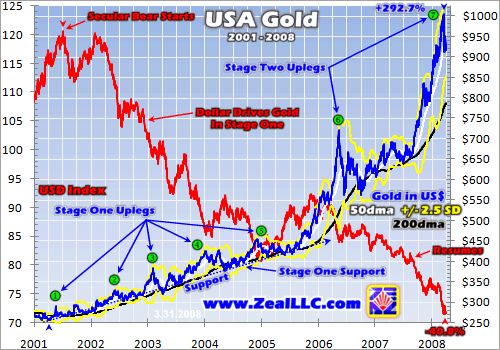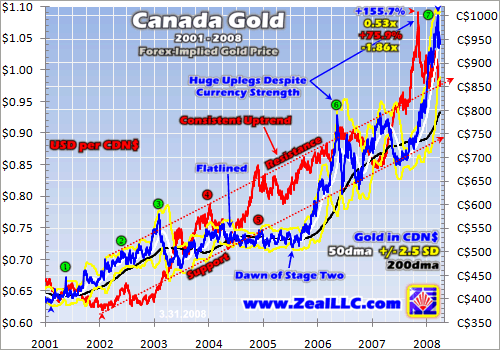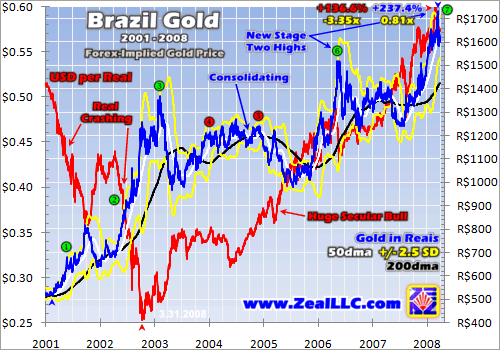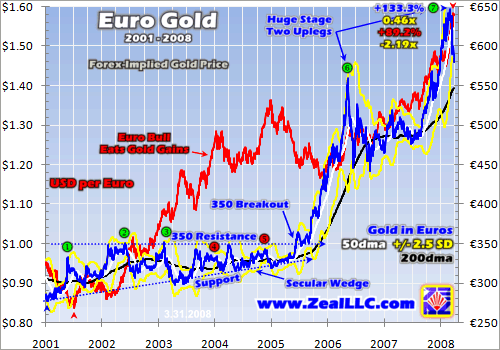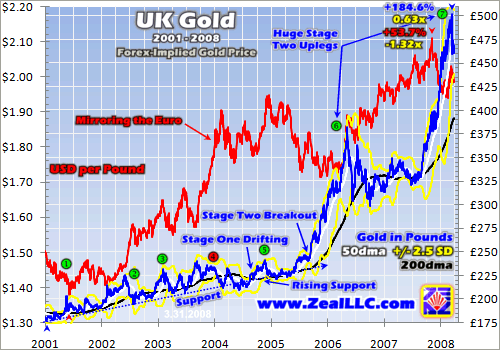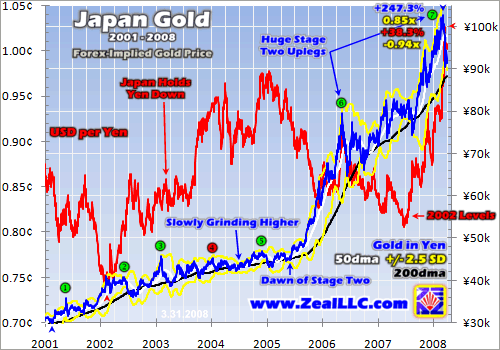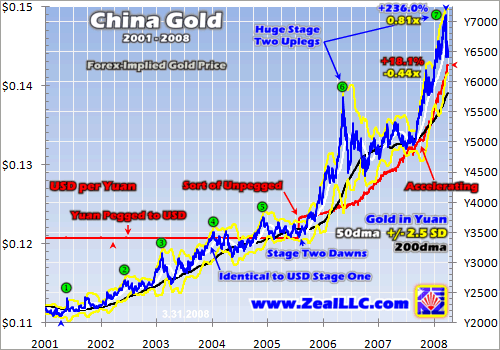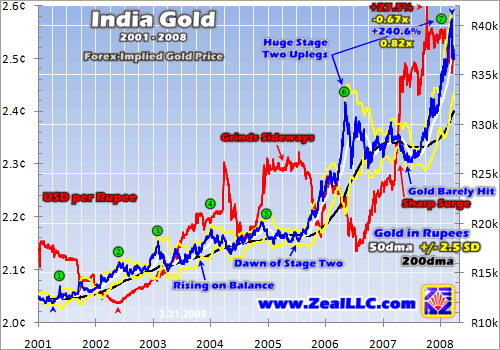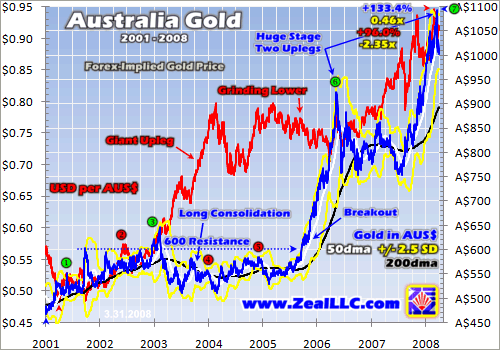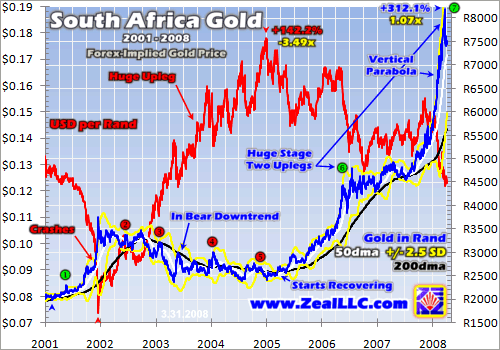|
|
|||||||
|
|
|
|
|
|
|
|
|
|
Global Gold 4 Adam Hamilton April 11, 2008 3128 Words
Of all the countless investments worldwide, gold is easily the most universally recognized. From the biggest banks in premier cosmopolitan cities to the smallest vendors in this planetís dustiest corners, everyone knows gold. This metalís timeless intrinsic value is beyond dispute and is welcome everywhere.
But although recognized, gold is not perceived the same way everywhere. We all view it through the unique lenses of our own home currencies. Most of us are born, reared, and socialized in a single country. By the time we reach investment age, our minds are hardwired to judge value exclusively relative to our particular countryís currency.
As an American, I see everything in US dollar terms. Sure, I am well aware the Fed is working overtime to destroy its fragile fiat currency. Yes, I certainly know the US dollarís hegemony is rapidly waning. Nevertheless, I was born and raised in a dollar world. Even as a longtime student of the global markets, my worldview is hopelessly dollar-centric. It is all Iíve ever known.
So I can only effectively wrap my mind around todayís secular gold bull in dollar terms. But if the vagaries of fate had seen me born in China, Iíd have the same mental handicap but think in yuan instead. And this gold bull wonít look the same in yuan as it does in US dollars. The same goes for all other currencies.
Averaging $926 US dollars per troy ounce in Q1 2008, gold is looking very strong to American investors like me. But how do investors in other countries perceive this bull? We can gain some idea by rendering it in their local currencies and examining the resulting charts. This exercise will help us understand whether global investors are more likely bullish and ready to buy gold or bearish and ready to sell.
In this series of essays, Iíve periodically looked at the gold price in ten major regional currencies. Three, the US dollar, euro, and yen, are truly global. The rest are heavyweights that dominate their particular region and are collectively used daily by the majority of the worldís population. Together they offer a great global survey of the state of this secular gold bull.
Weíll start with the US dollar reference chart. Despite the best efforts of Alan Greenspan and Ben Bernanke to irreparably ruin global confidence in the dollar, for decades the gold markets have been priced in US dollars all over the world. This is getting increasingly problematic, and the dollarís remaining days as the world reserve currency are certainly numbered, but for now it is still king in the gold world.
Over a challenging decade where the US stock markets have ground sideways to lower at best, gold has been a phenomenal investment. This metal that was so despised in the early 2000s has nearly quadrupled! While stock investors are getting ever poorer as the Fedís inflation relentlessly erodes their real wealth, gold investors are getting richer and richer. Early contrarians have already earned fortunes.
The US dollarís secular bear is just as striking. Since mid-2001, the US Dollar Index has shed nearly 41% of its value! Since gold is the worldís oldest and most successful global currency, it has definitely benefited from the Fedís gross mismanagement of the dollar. But the dollarís behavior has plagued perceptions of this gold bull for its entire advance. Investors tend to attribute far too much to the US dollar.
Back in Stage One, the dollar bear was indeed the primary driver of this gold bull. But when Stage Two dawned in mid-2005, global investment demand usurped the flagging dollar as goldís primary driver. The differences between the Stage One and Stage Two gold bulls are vast and readily evident in all currencies.
In Stage One foreign investors largely ignored the young gold bull, which they believed was simply a dollar bear. They overlooked subtle signs that could have earned them fortunes, like rising secular support lines in their local-currency gold prices. But nearly three years into Stage Two, today they definitely believe. It is too bad the dollar bearís importance was overestimated back when they couldíve bought really cheap gold.
Today in Stage Two, American mainstream investors generally believe gold is rising only because the US dollar is falling. This is a silly thesis though! If this gold bull was merely a dollar-bear thing, gold would be up about the same 41% as the US dollar is down. But gold is up 293%, far more than the dollar alone can explain. This myopia prevents them from understanding soaring global investment demand for gold.
So if you are an American suckered into believing Wall Streetís party line on gold merely being the anti-dollar, perusing the following charts will be very good for you. If gold was climbing simply to reflect a devaluing dollar, it would track fairly flat in most other currencies. But this gold bull is universal, a worldwide investment-driven juggernaut no longer shackled to inverse-mirroring the US dollarís sorry fate.
On these next nine charts, the gold prices are forex-implied based on the US-dollar-per-local-currency exchange rates. And regardless of local custom, all gold prices are quoted in local currency per troy ounce for comparability. The seven major highs in USD gold, shown above with the green numbers, are noted on all charts for reference points. If they donít mark a new local-currency-gold-bull high, they are shown in red.
The exchange rates are all computed in the same direction (USD per local) so a rising red line always means a currency is gaining strength against the US dollar. The secular gains in gold and local-currency exchange rates are compared with the reference baselines in the US dollar chart above. The yellow numbers show these results as multiples of the gains in USD gold and the losses in the US Dollar Index.
Back in Stage One Canada gold didnít really do all that much, and it was flatlined in a tight range for several years before the dawn of Stage Two. But boy, Stage Two hit like a freight train! Canada gold witnessed two huge uplegs despite persistent Canadian dollar strength. The Canadian dollar rallied 76% in a very consistent secular-bull uptrend, yet Canada gold still soared 156%, 0.53x as far as USD gold.
Canada, of course, is a hotbed for gold mining. I heard from a lot of Canadians in the early 2000s who were understandably not very excited about gold. But with dazzling record gold highs today, the legions of small exploration companies in the Great White North are going to be a lot more motivated to find new gold deposits to bring to market. If you like high-potential Canadian juniors, rejoice for C$1000 gold!
Iím not sure where Ben Bernanke studied economics, but based on his handling of the US dollar my guess is somewhere in Latin America. This region has long been plagued by incredibly mismanaged and weak currencies. And Brazil, despite being the strongest economy in this area by far, is no exception. The Brazilian real went on one wild ride, crashing in the early 2000s which drove a massive surge in gold.
After this crisis, the real started climbing in a huge secular bull. But instead of correcting, gold simply consolidated high despite the realís strength. Brazil gold has recently hit major new highs in Stage Two. Despite a 137% trough-to-crest run higher in the real, Brazil gold still managed a very impressive 237% bull of its own. Global gold investment demand is driving gold higher even in the strongest currencies.
The great collective wealth of the Europeans coupled with their insatiable cultural lust for gold made euro gold critical for this entire global bull. Back in the early 2000s, euro gold couldnít break above its long-vexing resistance at Ä350. So European investors understandably concluded that gold was not in a bull market. They figured we excitable Americans were simply too dimwitted to realize it was just a dollar bear in disguise.
Yet itís not just higher highs that make a bull, but higher lows. Euro goldís support line was inexorably rising as each correction grew weaker and weaker. I called it a stealth bull. But the Europeans wouldnít believe until the momentous mid-2005 Ä350 breakout. When it happened, I wrote that Stage Two had dawned. And history now proves it had indeed! Euro gold has rocketed higher in both Stage Two uplegs since.
Today the euro is the key contender to usurp the US dollarís throne to become the new global reserve currency. Heavy euro buying as big investors diversify out of dollars has driven a massive 89% bull run in the euro. Despite such strength, euro gold is still up 133%! This is absolute incontrovertible evidence that goldís bull is a worldwide phenomenon driven by global investment demand. The notion it is merely a US dollar thing today is laughably naÔve!
Thanks to the giant moat surrounding it, the UK can usually do its own thing without worrying much about other war-loving Europeans invading it. So it hasnít yet joined the euro party. Nevertheless, the pound sterling has mirrored the euroís march higher very well. So UK gold looks very much like euro gold. This is important since London remains the capital of the gold world and a leading money center.
UK gold didnít do much during Stage One when the dollar bear was goldís main driver, but it has soared in the pair of huge Stage Two uplegs since. This is another key example of gold rising in the face of a very strong local currency. Only soaring global investment demand can drive such a universal omni-currency gold bull. Record pound gold is very bullish and will entice a lot of new capital into chasing this metal.
Japan is a proud adherent of the Bernanke school of currency destruction. It has relentlessly devalued its yen to try and keep pace with the US dollar bear in hopes of maintaining its brisk export business to American consumers. All of this holding down the yen has led to a pretty flat currency chart. Trough to crest the yen has only managed to rise slightly less than the US dollar has fallen.
Despite all this blatant currency manipulation, Japan gold has had an awesome bull run, especially since the dawn of Stage Two. Like in Europe, huge pools of wealth exist in Japan. And like investors everywhere, there is nothing like new record highs to get the Japanese interested in buying into a bull. Artificially-low interest rates make gold even more appealing to the Japanese, since they canít earn a yield in bonds anyway. Maybe Bernanke studied economics in Japan.
The Chinese are also heavy exporters to the States, so they long had their yuan hard-pegged to the US dollar. They sort of unpegged it in mid-2005 near the dawn of Stage Two, but it was still subject to tight daily trading boundaries. Since then the yuan was been accelerating higher, but we are still looking at a modest 18% total gain which is easily the lowest witnessed in all nine of these major regional currencies.
Thanks to the yuan pegging, the Stage One China gold bull is identical to the USD gold bull. Stage Two has been smaller than USD goldís as the yuan rises, but only slightly. China gold is also at record highs and investment demand for gold by mainstream Chinese investors is soaring. With their love for gold and high savings rates, the Chinese are going to be a major demand-side driver of this gold bull going forward.
Today India is the worldís biggest gold consumer by far. Indians are shrewd gold buyers very sensitive to the gold price. Yet they have still helped drive the pair of huge Stage Two uplegs seen around the world. Like all investors, the higher the price of an asset goes the more the Indians want it. So sustained high India gold prices are very bullish for global investment demand since India is such a big component of it.
The rupee has also been weak, but it has still risen over the course of this gold bull. The vast majority of this currencyís entire secular bull occurred quickly in late 2006 and early 2007. Yet despite this sharp surge, gold barely retreated. In Stage Two gold demand is so universal that it transcends sharp moves in any one currency, even within the worldís biggest gold consumer. Indians are leading Stage Two buying.
Like Canada, Australia has had a very strong currency in the 2000s. Much of these gains occurred in a giant Aussie dollar upleg in 2003. Unfortunately this helped drive local gold prices into a long consolidation under A$600 resistance. Australians didnít enjoy this gold bull in Stage One, like the Europeans, so they didnít even believe a gold bull existed. This was certainly a rational stance based on the local gold price.
But everything changed in Stage Two, when Australia gold rocketed higher in that pair of huge Stage Two uplegs. These new highs are getting Australian investors excited about gold again and leading to something of a renaissance in gold exploration on this resource-rich continent. A 133% gold bull despite a 96% currency bull really drives home the global nature of soaring gold investment demand.
For 101 consecutive years, South Africa was the worldís largest gold producer. But last year China usurped it! All kinds of problems are hammering South African gold output, ranging from a Marxist anti-investor government to inadequate infrastructure (like electricity) to support large-scale mining. Its rising currency has also seriously hurt the miners that have to pay costs in rand but sell gold in US dollars.
These factors actually put South Africa gold in a multi-year bear downtrend following a big spike on the late-2001 rand crash. But as Stage Two was preparing to dawn, gold started to recover. South African investors have since enjoyed the same pair of huge Stage Two uplegs that the rest of the world has witnessed. The resulting high prices, if sustained, will help the big SA miners grow their profits again.
After looking at all ten of these global gold charts, some key themes emerge. Most importantly, this gold bull is absolutely global in nature. Dazzling new record highs have been seen in local-currency gold prices in all major currencies worldwide. The Wall Street arguments today claiming that gold is rising just because the US dollar is falling are simply shortsighted and false. Global investment demand is the driver.
It is true that the dollar bear was goldís primary driver back in Stage One, prior to mid-2005. Gold did indeed mostly reflect the dollar devaluation up to that point, which means it didnít do much at all in other major currencies like the euro. But that era is long gone. In the second stage of secular gold bulls, this metal decouples from the dominant devaluing currency. This happened in summer 2005.
So American traders today, particularly Wall Streeters and futures guys, who think the US dollar weakness is the key to this gold bull are woefully mistaken. While gold does still tend to move opposite to the dollar tactically on a day-to-day basis, strategically it has totally decoupled. Goldís gains not only dwarf the US dollarís losses, but the fact that it is rising dramatically all over the world refutes this dollar-centric thesis.
Another key insight these global gold charts offer is psychological. For most of the things people buy, higher prices retard demand. You may like a cup of coffee every morning for $4, but would you pay $40 for one? I doubt it. But in the investing world, economic principles are flipped on their heads. Higher prices from recent gains make any investment much more appealing to the masses than lower prices.
Back in early 2001, regardless of where they were in the world or what currency they thought in terms of, gold didnít excite many investors. Cheap investments are loathed, as investors extrapolate the downtrends that led to their low prices out into infinity. But today, with gold continuing to carve new record highs all over the world, more and more investors are getting excited about this metal everywhere.
This excitement leads to buying, deploying capital. But freshly-mined gold supplies are already heavily constrained and central banksí hoards are getting smaller and smaller thanks to their endless gold sales and a growing world gold market. Thus soaring global investment demand driven by record gold prices sparking greed cannot be met by any type of supply growth. So gold prices will have to continue higher.
But of course the higher they go, the more new investors will be enticed in and the greater excitement will build. This creates a wonderful virtuous circle that ultimately culminates in a Stage Three gold bull. This is a popular mania where goldlust spills out of the investing world to seize the dreams of ordinary people in the streets. This is when gold will truly shoot vertical, probably briefly climaxing over US$4000 per ounce!
While I suspect we are some years away from a Stage Three mania yet, todayís global gold bull is certainly laying the groundwork. Slowly but surely gold, like any secular bull, is winning respect and capital within the global investment world. Record highs make this metal much more appealing to investors. This is a universal and immutable human trait that respects no national or currency boundaries.
At Zeal, we were among the earliest gold investors. I first formally recommended gold as an investment to our newsletter subscribers at $264 in early May 2001. But while gold is slowly gaining respect today, gold stocks are struggling. Sooner or later they will be aggressively bid up to reflect this new higher-gold-price world. Subscribe to our acclaimed monthly newsletter today and deploy some risk capital in elite under-appreciated high-potential gold stocks! We also just published a new report on our favorite junior golds.
The bottom line is goldís bull market is universal and global, far transcending the myopic and quaint dollar-centric notions Wall Street is babbling about today. True, there was a time when the US dollar bear drove gold. But that became history when Stage Two dawned in mid-2005. Since then gold has risen powerfully all over the world, in all currencies, because soaring global investment demand is driving it higher.
And nothing begets more investment demand like sharp runs higher leading to record prices. Investors who would have scoffed at gold three years ago are starting to pay attention today. The higher it runs, the more they will want it. Nothing sparks greed in the human heart like gold, as history testifies abundantly. Todayís early Stage Two uplegs are the vanguard of a coming massive shift into hard assets.
Adam Hamilton, CPA April 11, 2008 Subscribe |
|||||||
|
|
|
|
|
|
|
|
|
|
|
|
|
|
|
|||

